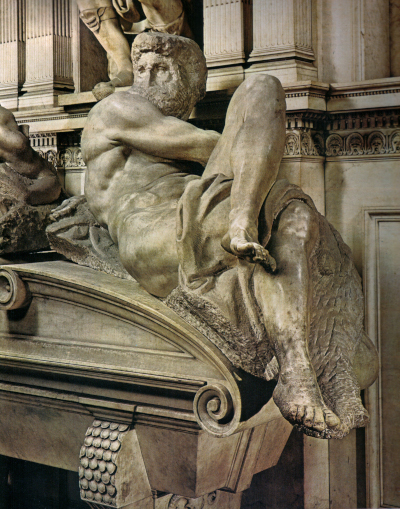Michelangelo had a complicated, but ultimately fruitful relationship with the influential Medici family. One of their highest profile collaborations would be on the four Times of the Day sculptures, which included Day as shown below.
The great master set about constructing four related marble sculptures which would each sit below portraits of members of the Medici family, within their respective tombs. In selecting a single artist for this work, a consistent finish across the series was assured. The four pieces would sit within the tombs of Giuliano de Medici and Lorenzo de Medici.
Whilst Michelangelo's work on this project reached a more complete state than many of his abandoned or cancelled commissions elsewhere in his career, there were still elements of each of the four sculptures that were not entirely finished. In respect of Day specifically, one can see that the facial features is only roughly done, with some of the original stone block left uncarved. One of his hands has also not been fully developed.
From afar, visitors to the two tombs may be entirely unaware of these elements that were not finished, and the overall display within both tombs works effectively. It may have been that in providing the artist with a series of sculptures in one commissioned project, that he was more able to complete the majority of the work than if he had been tasked with completing each sculpture one at a time.
Table of Contents
- Description
- Where is the Tomb of Giuliano de' Medici?
- Michelangelo's Work on the Tomb of Giuliano de' Medici
- What are the Times of the Day Sculptures?
- Timeline
- Size and Medium
Description
Day features an impressively toned man, who displays Michelangelo's incredible skills in accurately replicating the human body. The figure has his back turned away from us, but with his head turned towards us. His left leg is angled, resting on his right thigh in a similar manner to some of the other sculptures in this series. A cloth is hung over his crotch area, in order to spare his blushes, and also the ensure the sculpture was palatable to the tastes of the time (amendments were famously made to his Last Judgement mural for much the same reasons).
The original marble rock from which his form was sculpted is still visible, though whether this was an artistic decision, or another way in which the piece was not finished, is unclear. Considering the style of the rest of each tomb, it is most likely that the intention would have been to remove this remaining part and have a smooth finish throughout each statue.
The figure's hair is also left in a fairly rugged form and it is relatively hard to determine the age of this figure, because part of his face is unfinished, and Michelangelo would always give his sculptured figures a smooth surface, regardless of the supposed age. Even his elderly figures would have toned physiques which was more of an idealised appearance than what he might have seen in real life Florence.
Day is perhaps closest in style to Dusk, with both featuring reclining men with strong physiques. They also tilt their heads towards us, when standing centrally within the tomb, though with their bodies lined along the curved section of the architecture. Indeed, perhaps Dusk gives us a good example of how the facial features of Day might have looked, were they finished at the time. Day is said to have represented a Herculean figure, with a menancing and aggressive expression.
Where is the Tomb of Giuliano de' Medici?
The Sagrestia Nuova sits within the Basilica of San Lorenzo in Florence and was designed by Michelangelo. The original intention was to complete four tombs here, but only two were ever completed. The Tomb of Giuliano de' Medici was one of those completed, and features Day and Night below a Portrait of Giuliano de' Medici, Duke of Nemours. Both tombs are arranged in a triangular format, which was common within Italian Renaissance sculpture.
It is believed that Michelangelo exited the project with most sculptures having been completed, but not yet arranged into the final display. This was therefore completed at a later date, probably by Niccolò Tribolo in the mid-16th century. Further amendments were then made a decade later, developing some of the work left by Michelangelo. The layout of both tombs today remains much the same and they are included within the larger location known as the Medici Chapels.
The Basilica di San Lorenzo is located centrally within the Italian city of Florence. The Old Sacristy and New Sacristy are just two sections of this impressive location, which remains one of the most popular attractions within the city. Art to be found here, outside of Michelangelo's own contributions, includes paintings by the likes of Bronzino, Fra Filippo Lippi as well as sculpture and architecture by Donatello and Andrea del Verrocchio.
Michelangelo's Work on the Tomb of Giuliano de' Medici
It was in 1520 that Michelangelo first received the commission to produce a complex design for the Medici Chapel. Giuliano and Lorenzo Medici were buried close by in the Old Sacristy of San Lorenzo at the time, and it was decided that they would be re-housed alongside two further Medici tombs. Michelangelo spent considerable time planning the sculpture and architecture for this commission, with many drawing studies that he produced at the time later being discovered in another part of the building.
Michelangelo placed the two figures above the Times of the Day sculptures in order to appear to raise the status of Giuliano and Lorenzo above what was represented below them. Essentially, they would enjoy a free spirit for eternity, whilst resting in their respective tombs. The architecture designs from Michelangelo found here are also particularly significant within his career, as a sign of his evolution, though much of what he planned was never implemented.
The overall tomb of Giuliano de' Medici measures 630 x 420 cm, and his work was completed between the years of 1526-33, although it is possible that some of his initial designs came earlier than that, when you consider that the original commission was awarded by Medici Pope Leo X (1513-23) in 1520. The two figures later buried here had been murdered in 1478, which may also have served as a warning to Michelangelo about the potential dangers of associating himself so closely with the Medici family. He was also known to have political differences with them, but had to accept the benefit that they could have on his career.
What are the Times of the Day Sculptures?
The four sculptures produced by Michelangelo of Day, Night, Dawn and Dusk are often known as his Times of the Day series. The similarity in style and layout of the four items, as well as the fact that he worked on them at the same time, has meant that discussing them as a collective series is entirely reasonable.
Timeline
Michelangelo's work on the Tomb of Giuliano de' Medici ran from approximately 1526–1534. He would also have been working on the related tomb of Lorenzo de' Medici during the same period. The statue of the Medici Madonna would also have been completed at around the same time, whilst in the years leading up to this important commission he was mainly working on his series of slaves, such as Awakening Slave, Atlas Slave and Bearded Slave. Those items spanned 1520–1523, which led perfectly into his major commission for the two Medici tombs (four were originally planned).
Size and Medium
Michelangelo's Day was built entirely in marble, with much of the original surface of the stone still visible. The overall piece stretches to 185 cm in length. The four parts of the series are all relatively similar in length, but far from identical, as Michelangelo sought a certain level of freedom of expression within each one.
Image Credit
The image included within this page was derived from the public domain, and was uploaded to Wikimedia Commons by Sailko. This excellent photograph is derived from Umberto Baldini, Michelangelo scultore, Rizzoli, Milano 1973 and is classed by Wikimedia as now being available for public domain usage. Those interested, can view the original image added to Wikimedia using the link below, as we have resized it down to a small format.
Day, 1524-1527 by Michelangelo, originally from Umberto Baldini, Michelangelo scultore, Rizzoli, Milano 1973; Sailko, Public Domain, via Wikimedia Commons
Bibliography
- Images sourced from Wikimedia under a variety of Creative Commons licenses. Further details regarding the particular license used, the location of the original image on Wikimedia and the original author/user are provided on each specific page.
- Michelangelo, Gilles Néret
- Vasari's Lives of the Artists, Giorgio Vasari
- Michelangelo. The Complete Works. Paintings, Sculptures, Architecture, Frank Zöllner, Christof Thoenes
- Michelangelo and the Sistine Chapel, Andrew Graham-Dixon




